In a former post, I talked about how working at the computer for several hours a day can cause problems for your eyes.
Studies have even found that over time, computers can change the composition of our tears, increasing risk of dry eye syndrome.
You can look away from the screen, move the monitor down, and check your lighting, among other things, to protect your vision. But you can also invest in some tools that will make it easier to see your words on the screen. Below are ten I found that may help.
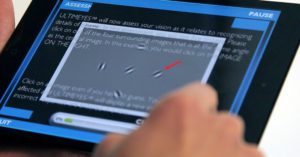 UltimEyes: This new app claims to actually help improve your vision through four simple 25-minute weekly sessions, practiced over a period of eight weeks. (It’s fun—like a video game.) Developed by Dr. Seitz, a leading researcher in the field of cognitive science and a professor at University of California, UltimEyes is designed to strengthen how the brain processes the visual input from the eyes. Studies conducted at the university showed an average 31 percent increase in eyesight. If you try it, let us know what you think of the results!
UltimEyes: This new app claims to actually help improve your vision through four simple 25-minute weekly sessions, practiced over a period of eight weeks. (It’s fun—like a video game.) Developed by Dr. Seitz, a leading researcher in the field of cognitive science and a professor at University of California, UltimEyes is designed to strengthen how the brain processes the visual input from the eyes. Studies conducted at the university showed an average 31 percent increase in eyesight. If you try it, let us know what you think of the results!
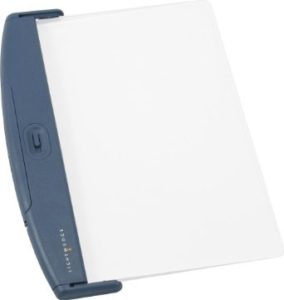 LightWedge LED Book Light: This page-sized acrylic lens lays flat on your page and focuses the two LED lights directly on what you’re reading. The benefit is that the light doesn’t go you’re your eyes or float around to bother a neighbor’s eyes. This may be the answer to reading before bed, or for reading while traveling. Requires 4 AAA batteries for about 40 hours of reading.
LightWedge LED Book Light: This page-sized acrylic lens lays flat on your page and focuses the two LED lights directly on what you’re reading. The benefit is that the light doesn’t go you’re your eyes or float around to bother a neighbor’s eyes. This may be the answer to reading before bed, or for reading while traveling. Requires 4 AAA batteries for about 40 hours of reading.
-
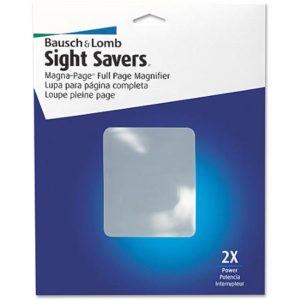 Full-Page Magnifier: These range from the very economical to the more complex lighted versions that cost a little bit more. Wal-mart carries the Bausch & Lomb 2X Magna-Page Full-Page Magnifier for only about $6. Place it over any page for instant magnification. If you want a bit more light, you can try the Lighted Full-Page Reading Magnifier, which has LEDs to light the page as well as magnify it.
Full-Page Magnifier: These range from the very economical to the more complex lighted versions that cost a little bit more. Wal-mart carries the Bausch & Lomb 2X Magna-Page Full-Page Magnifier for only about $6. Place it over any page for instant magnification. If you want a bit more light, you can try the Lighted Full-Page Reading Magnifier, which has LEDs to light the page as well as magnify it.
-
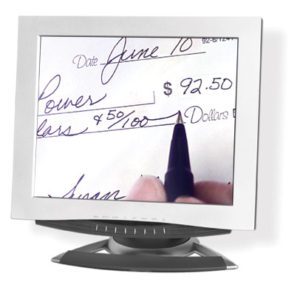 VideoEye: This technology was originally designed for the visually impaired, but it can be useful for anyone who wants to easily text and objects onto a computer monitor for easy viewing. It uses a camera to relay a magnified image onto a television screen. The viewing head is mounted onto a balanced spring arm, so it’s easy to move and adjust. This can be particularly helpful for those who write by hand. Simply position the viewing head over your writing area and see your own writing much larger and clearer on screen.
VideoEye: This technology was originally designed for the visually impaired, but it can be useful for anyone who wants to easily text and objects onto a computer monitor for easy viewing. It uses a camera to relay a magnified image onto a television screen. The viewing head is mounted onto a balanced spring arm, so it’s easy to move and adjust. This can be particularly helpful for those who write by hand. Simply position the viewing head over your writing area and see your own writing much larger and clearer on screen.
-
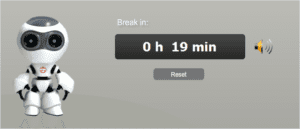 20-20-Break: Ask your eye doctor and he or she will tell you—every twenty minutes, look away from the screen and focus on something 20 feet away. This gives your close-up vision a break and allows your distance vision to take over—good for your eyes. There are few of us that can keep track of time that carefully, however, especially when we’re knee-deep in a writing project. Fortunately, there are add-ons for both Firefox and Chrome that will help remind you. Protectyourvision.org has one for Firefox, and 20-Cubed is a similar solution for Chrome.
20-20-Break: Ask your eye doctor and he or she will tell you—every twenty minutes, look away from the screen and focus on something 20 feet away. This gives your close-up vision a break and allows your distance vision to take over—good for your eyes. There are few of us that can keep track of time that carefully, however, especially when we’re knee-deep in a writing project. Fortunately, there are add-ons for both Firefox and Chrome that will help remind you. Protectyourvision.org has one for Firefox, and 20-Cubed is a similar solution for Chrome.
-
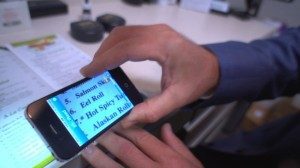 Smart Phone Apps: There are several apps available that use the camera and light source on your phone to magnify and illuminate text. These essentially turn your phone into a lighted magnifying glass. You may find them particularly handy if you’re trying to read a printed page while in a dark public place or if you left your reading light at home. iRead works for iPhones and Android phones. Magnifier also works with Android phones.
Smart Phone Apps: There are several apps available that use the camera and light source on your phone to magnify and illuminate text. These essentially turn your phone into a lighted magnifying glass. You may find them particularly handy if you’re trying to read a printed page while in a dark public place or if you left your reading light at home. iRead works for iPhones and Android phones. Magnifier also works with Android phones.
- Computer screen brightness apps: If you’re taking your notebook to various places to write, you’re going to encounter different lighting conditions. Some applications help adjust the lighting on your screen to make it easier to read. “Shades” works with Mac and will apply a tint to your monitor that you can adjust. Pangobright works with Windows and dims the lights on your screen based on your preferences. F.lux is particularly helpful for those who work late at night, as it dims the light on the screen so they don’t interfere with melatonin production (which can lead to insomnia). It’s available for Mac and Windows.
-
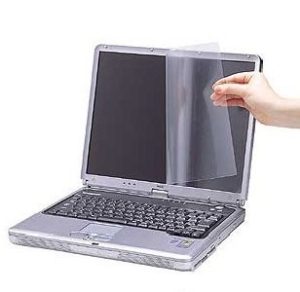 Anti-glare filter: You can find all types of these online and at office stores. They vary in size and price, and come in varieties to fit your computer monitor, tablet, and phone. Most are easy to apply and remove and offer screen protection in addition to reducing glare and mirror-like reflections.
Anti-glare filter: You can find all types of these online and at office stores. They vary in size and price, and come in varieties to fit your computer monitor, tablet, and phone. Most are easy to apply and remove and offer screen protection in addition to reducing glare and mirror-like reflections.
-
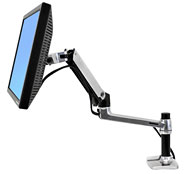 Monitor mount: These make it easier for you to adjust your screen for improved ergonomics and to help make sure your monitor is at the optimal place for easy viewing. You can reduce eye, neck, and back strain by setting one of these up on your desk. They can also free-up more space in your work area. Find an example from Ergotron here.
Monitor mount: These make it easier for you to adjust your screen for improved ergonomics and to help make sure your monitor is at the optimal place for easy viewing. You can reduce eye, neck, and back strain by setting one of these up on your desk. They can also free-up more space in your work area. Find an example from Ergotron here.
- Try Gunnars glasses: These were originally designed for gamers, but we writers use the computer just as much, if not more. The glasses offset the blue light the computer emits (while also blocking UV), easing strain on the eyes, and also magnify a little bit, making reading easier. The manufacturer promises sharper, clearer vision, less eyestrain, and reduced symptoms of dry eye. The glasses come in a variety of styles. You can even get customized prescription models.
Do you have other tools you use to ease eyestrain? Please share any tips you have with our readers.


Great tips! I use and love the LightWedge for reading before bed (if I’m not reading my Kindle). To ease eye strain, I have an enormous monitor that I hook up to my laptop. It’s 18 or 20 inches by 16-ish inches and takes up most of my desk, but it saves my eyes, so it’s well worth it.
Great tip on the monitor, Chere. Thanks!